Jianshu Zhang
May
VLM$^2$-Bench: A Closer Look at How Well VLMs Implicitly Link Explicit Matching Visual Cues
Feb 17, 2025Abstract:Visually linking matching cues is a crucial ability in daily life, such as identifying the same person in multiple photos based on their cues, even without knowing who they are. Despite the extensive knowledge that vision-language models (VLMs) possess, it remains largely unexplored whether they are capable of performing this fundamental task. To address this, we introduce VLM$^2$-Bench, a benchmark designed to assess whether VLMs can Visually Link Matching cues, with 9 subtasks and over 3,000 test cases. Comprehensive evaluation across eight open-source VLMs and GPT-4o, along with further analysis of various language-side and vision-side prompting methods, leads to a total of eight key findings. We identify critical challenges in models' ability to link visual cues, highlighting a significant performance gap where even GPT-4o lags 34.80% behind humans. Based on these insights, we advocate for (i) enhancing core visual capabilities to improve adaptability and reduce reliance on prior knowledge, (ii) establishing clearer principles for integrating language-based reasoning in vision-centric tasks to prevent unnecessary biases, and (iii) shifting vision-text training paradigms toward fostering models' ability to independently structure and infer relationships among visual cues.
Fast Adaptive Anti-Jamming Channel Access via Deep Q Learning and Coarse-Grained Spectrum Prediction
Feb 07, 2025Abstract:This paper investigates the anti-jamming channel access problem in complex and unknown jamming environments, where the jammer could dynamically adjust its strategies to target different channels. Traditional channel hopping anti-jamming approaches using fixed patterns are ineffective against such dynamic jamming attacks. Although the emerging deep reinforcement learning (DRL) based dynamic channel access approach could achieve the Nash equilibrium under fast-changing jamming attacks, it requires extensive training episodes. To address this issue, we propose a fast adaptive anti-jamming channel access approach guided by the intuition of ``learning faster than the jammer", where a synchronously updated coarse-grained spectrum prediction serves as an auxiliary task for the deep Q learning (DQN) based anti-jamming model. This helps the model identify a superior Q-function compared to standard DRL while significantly reducing the number of training episodes. Numerical results indicate that the proposed approach significantly accelerates the rate of convergence in model training, reducing the required training episodes by up to 70% compared to standard DRL. Additionally, it also achieves a 10% improvement in throughput over NE strategies, owing to the effective use of coarse-grained spectrum prediction.
Skeleton and Font Generation Network for Zero-shot Chinese Character Generation
Jan 14, 2025Abstract:Automatic font generation remains a challenging research issue, primarily due to the vast number of Chinese characters, each with unique and intricate structures. Our investigation of previous studies reveals inherent bias capable of causing structural changes in characters. Specifically, when generating a Chinese character similar to, but different from, those in the training samples, the bias is prone to either correcting or ignoring these subtle variations. To address this concern, we propose a novel Skeleton and Font Generation Network (SFGN) to achieve a more robust Chinese character font generation. Our approach includes a skeleton builder and font generator. The skeleton builder synthesizes content features using low-resource text input, enabling our technique to realize font generation independently of content image inputs. Unlike previous font generation methods that treat font style as a global embedding, we introduce a font generator to align content and style features on the radical level, which is a brand-new perspective for font generation. Except for common characters, we also conduct experiments on misspelled characters, a substantial portion of which slightly differs from the common ones. Our approach visually demonstrates the efficacy of generated images and outperforms current state-of-the-art font generation methods. Moreover, we believe that misspelled character generation have significant pedagogical implications and verify such supposition through experiments. We used generated misspelled characters as data augmentation in Chinese character error correction tasks, simulating the scenario where students learn handwritten Chinese characters with the help of misspelled characters. The significantly improved performance of error correction tasks demonstrates the effectiveness of our proposed approach and the value of misspelled character generation.
Bridge-Coder: Unlocking LLMs' Potential to Overcome Language Gaps in Low-Resource Code
Oct 24, 2024
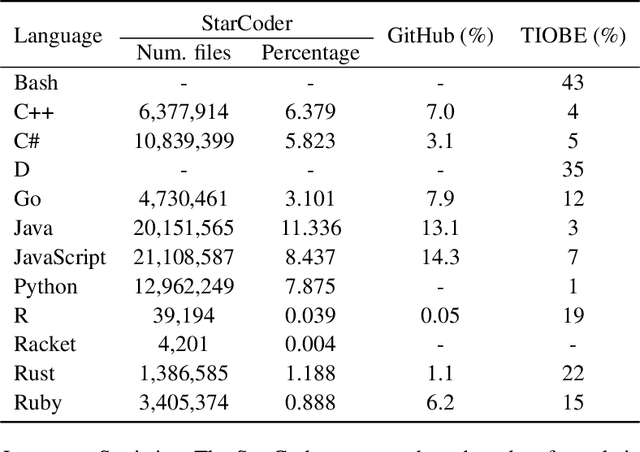

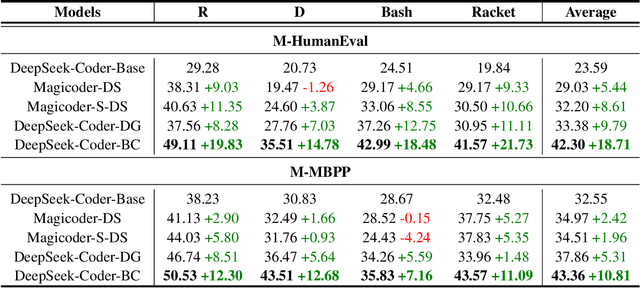
Abstract:Large Language Models (LLMs) demonstrate strong proficiency in generating code for high-resource programming languages (HRPLs) like Python but struggle significantly with low-resource programming languages (LRPLs) such as Racket or D. This performance gap deepens the digital divide, preventing developers using LRPLs from benefiting equally from LLM advancements and reinforcing disparities in innovation within underrepresented programming communities. While generating additional training data for LRPLs is promising, it faces two key challenges: manual annotation is labor-intensive and costly, and LLM-generated LRPL code is often of subpar quality. The underlying cause of this issue is the gap between natural language to programming language gap (NL-PL Gap), which is especially pronounced in LRPLs due to limited aligned data. In this work, we introduce a novel approach called Bridge-Coder, which leverages LLMs' intrinsic capabilities to enhance the performance on LRPLs. Our method consists of two key stages. Bridge Generation, where we create high-quality dataset by utilizing LLMs' general knowledge understanding, proficiency in HRPLs, and in-context learning abilities. Then, we apply the Bridged Alignment, which progressively improves the alignment between NL instructions and LRPLs. Experimental results across multiple LRPLs show that Bridge-Coder significantly enhances model performance, demonstrating the effectiveness and generalization of our approach. Furthermore, we offer a detailed analysis of the key components of our method, providing valuable insights for future work aimed at addressing the challenges associated with LRPLs.
Personalized Visual Instruction Tuning
Oct 09, 2024



Abstract:Recent advancements in multimodal large language models (MLLMs) have demonstrated significant progress; however, these models exhibit a notable limitation, which we refer to as "face blindness". Specifically, they can engage in general conversations but fail to conduct personalized dialogues targeting at specific individuals. This deficiency hinders the application of MLLMs in personalized settings, such as tailored visual assistants on mobile devices, or domestic robots that need to recognize members of the family. In this paper, we introduce Personalized Visual Instruction Tuning (PVIT), a novel data curation and training framework designed to enable MLLMs to identify target individuals within an image and engage in personalized and coherent dialogues. Our approach involves the development of a sophisticated pipeline that autonomously generates training data containing personalized conversations. This pipeline leverages the capabilities of various visual experts, image generation models, and (multi-modal) large language models. To evaluate the personalized potential of MLLMs, we present a benchmark called P-Bench, which encompasses various question types with different levels of difficulty. The experiments demonstrate a substantial personalized performance enhancement after fine-tuning with our curated dataset.
See then Tell: Enhancing Key Information Extraction with Vision Grounding
Sep 29, 2024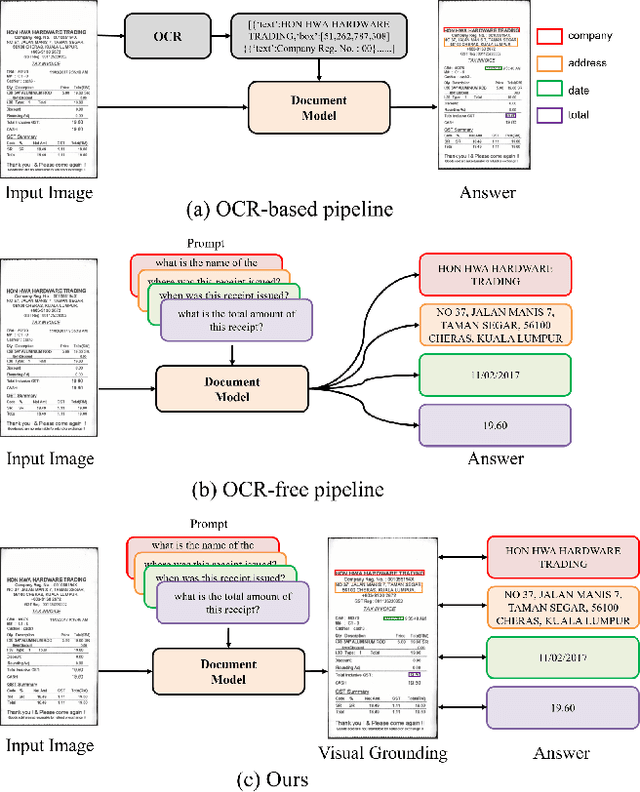
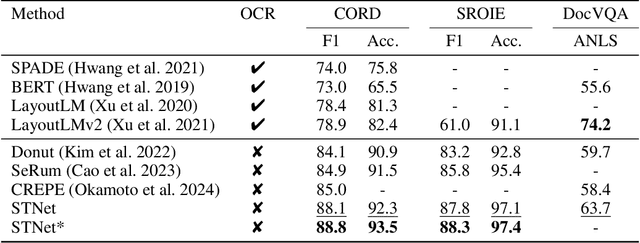
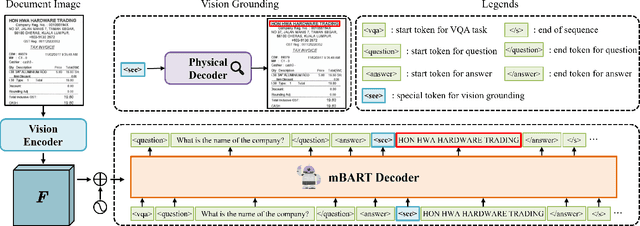

Abstract:In the digital era, the ability to understand visually rich documents that integrate text, complex layouts, and imagery is critical. Traditional Key Information Extraction (KIE) methods primarily rely on Optical Character Recognition (OCR), which often introduces significant latency, computational overhead, and errors. Current advanced image-to-text approaches, which bypass OCR, typically yield plain text outputs without corresponding vision grounding. In this paper, we introduce STNet (See then Tell Net), a novel end-to-end model designed to deliver precise answers with relevant vision grounding. Distinctively, STNet utilizes a unique <see> token to observe pertinent image areas, aided by a decoder that interprets physical coordinates linked to this token. Positioned at the outset of the answer text, the <see> token allows the model to first see--observing the regions of the image related to the input question--and then tell--providing articulated textual responses. To enhance the model's seeing capabilities, we collect extensive structured table recognition datasets. Leveraging the advanced text processing prowess of GPT-4, we develop the TVG (TableQA with Vision Grounding) dataset, which not only provides text-based Question Answering (QA) pairs but also incorporates precise vision grounding for these pairs. Our approach demonstrates substantial advancements in KIE performance, achieving state-of-the-art results on publicly available datasets such as CORD, SROIE, and DocVQA. The code will also be made publicly available.
DocMamba: Efficient Document Pre-training with State Space Model
Sep 18, 2024



Abstract:In recent years, visually-rich document understanding has attracted increasing attention. Transformer-based pre-trained models have become the mainstream approach, yielding significant performance gains in this field. However, the self-attention mechanism's quadratic computational complexity hinders their efficiency and ability to process long documents. In this paper, we present DocMamba, a novel framework based on the state space model. It is designed to reduce computational complexity to linear while preserving global modeling capabilities. To further enhance its effectiveness in document processing, we introduce the Segment-First Bidirectional Scan (SFBS) to capture contiguous semantic information. Experimental results demonstrate that DocMamba achieves new state-of-the-art results on downstream datasets such as FUNSD, CORD, and SORIE, while significantly improving speed and reducing memory usage. Notably, experiments on the HRDoc confirm DocMamba's potential for length extrapolation. The code will be available online.
FIRST: Teach A Reliable Large Language Model Through Efficient Trustworthy Distillation
Aug 22, 2024Abstract:Large language models (LLMs) have become increasingly prevalent in our daily lives, leading to an expectation for LLMs to be trustworthy -- - both accurate and well-calibrated (the prediction confidence should align with its ground truth correctness likelihood). Nowadays, fine-tuning has become the most popular method for adapting a model to practical usage by significantly increasing accuracy on downstream tasks. Despite the great accuracy it achieves, we found fine-tuning is still far away from satisfactory trustworthiness due to "tuning-induced mis-calibration". In this paper, we delve deeply into why and how mis-calibration exists in fine-tuned models, and how distillation can alleviate the issue. Then we further propose a brand new method named Efficient Trustworthy Distillation (FIRST), which utilizes a small portion of teacher's knowledge to obtain a reliable language model in a cost-efficient way. Specifically, we identify the "concentrated knowledge" phenomenon during distillation, which can significantly reduce the computational burden. Then we apply a "trustworthy maximization" process to optimize the utilization of this small portion of concentrated knowledge before transferring it to the student. Experimental results demonstrate the effectiveness of our method, where better accuracy (+2.3%) and less mis-calibration (-10%) are achieved on average across both in-domain and out-of-domain scenarios, indicating better trustworthiness.
SRFUND: A Multi-Granularity Hierarchical Structure Reconstruction Benchmark in Form Understanding
Jun 13, 2024Abstract:Accurately identifying and organizing textual content is crucial for the automation of document processing in the field of form understanding. Existing datasets, such as FUNSD and XFUND, support entity classification and relationship prediction tasks but are typically limited to local and entity-level annotations. This limitation overlooks the hierarchically structured representation of documents, constraining comprehensive understanding of complex forms. To address this issue, we present the SRFUND, a hierarchically structured multi-task form understanding benchmark. SRFUND provides refined annotations on top of the original FUNSD and XFUND datasets, encompassing five tasks: (1) word to text-line merging, (2) text-line to entity merging, (3) entity category classification, (4) item table localization, and (5) entity-based full-document hierarchical structure recovery. We meticulously supplemented the original dataset with missing annotations at various levels of granularity and added detailed annotations for multi-item table regions within the forms. Additionally, we introduce global hierarchical structure dependencies for entity relation prediction tasks, surpassing traditional local key-value associations. The SRFUND dataset includes eight languages including English, Chinese, Japanese, German, French, Spanish, Italian, and Portuguese, making it a powerful tool for cross-lingual form understanding. Extensive experimental results demonstrate that the SRFUND dataset presents new challenges and significant opportunities in handling diverse layouts and global hierarchical structures of forms, thus providing deep insights into the field of form understanding. The original dataset and implementations of baseline methods are available at https://sprateam-ustc.github.io/SRFUND
Image Textualization: An Automatic Framework for Creating Accurate and Detailed Image Descriptions
Jun 11, 2024Abstract:Image description datasets play a crucial role in the advancement of various applications such as image understanding, text-to-image generation, and text-image retrieval. Currently, image description datasets primarily originate from two sources. One source is the scraping of image-text pairs from the web. Despite their abundance, these descriptions are often of low quality and noisy. Another is through human labeling. Datasets such as COCO are generally very short and lack details. Although detailed image descriptions can be annotated by humans, the high annotation cost limits the feasibility. These limitations underscore the need for more efficient and scalable methods to generate accurate and detailed image descriptions. In this paper, we propose an innovative framework termed Image Textualization (IT), which automatically produces high-quality image descriptions by leveraging existing multi-modal large language models (MLLMs) and multiple vision expert models in a collaborative manner, which maximally convert the visual information into text. To address the current lack of benchmarks for detailed descriptions, we propose several benchmarks for comprehensive evaluation, which verifies the quality of image descriptions created by our framework. Furthermore, we show that LLaVA-7B, benefiting from training on IT-curated descriptions, acquire improved capability to generate richer image descriptions, substantially increasing the length and detail of their output with less hallucination.
 Add to Chrome
Add to Chrome Add to Firefox
Add to Firefox Add to Edge
Add to Edge